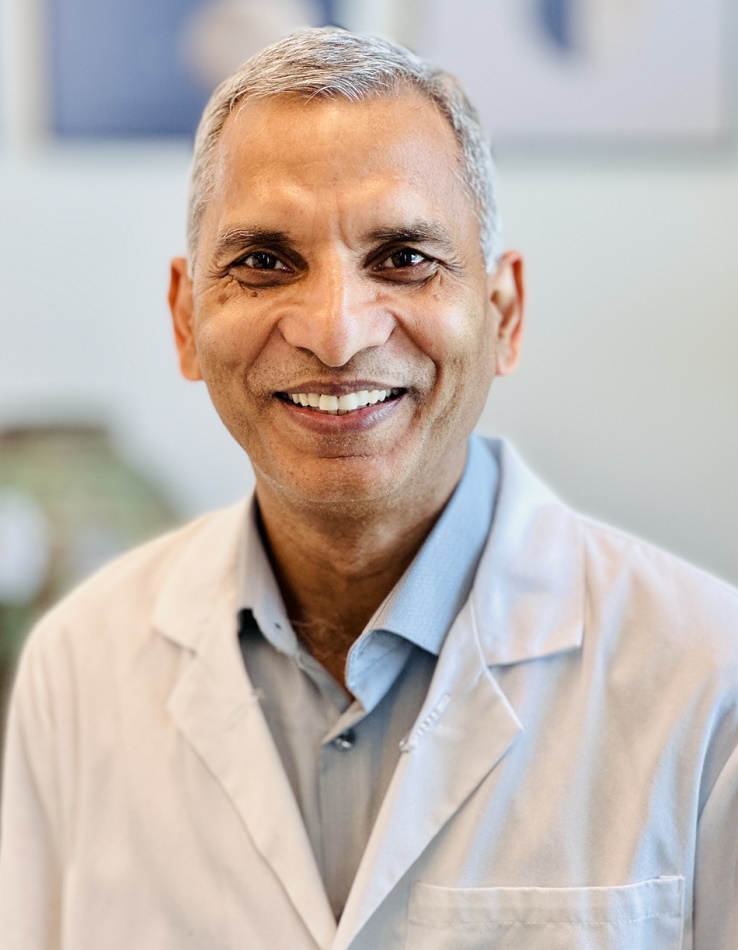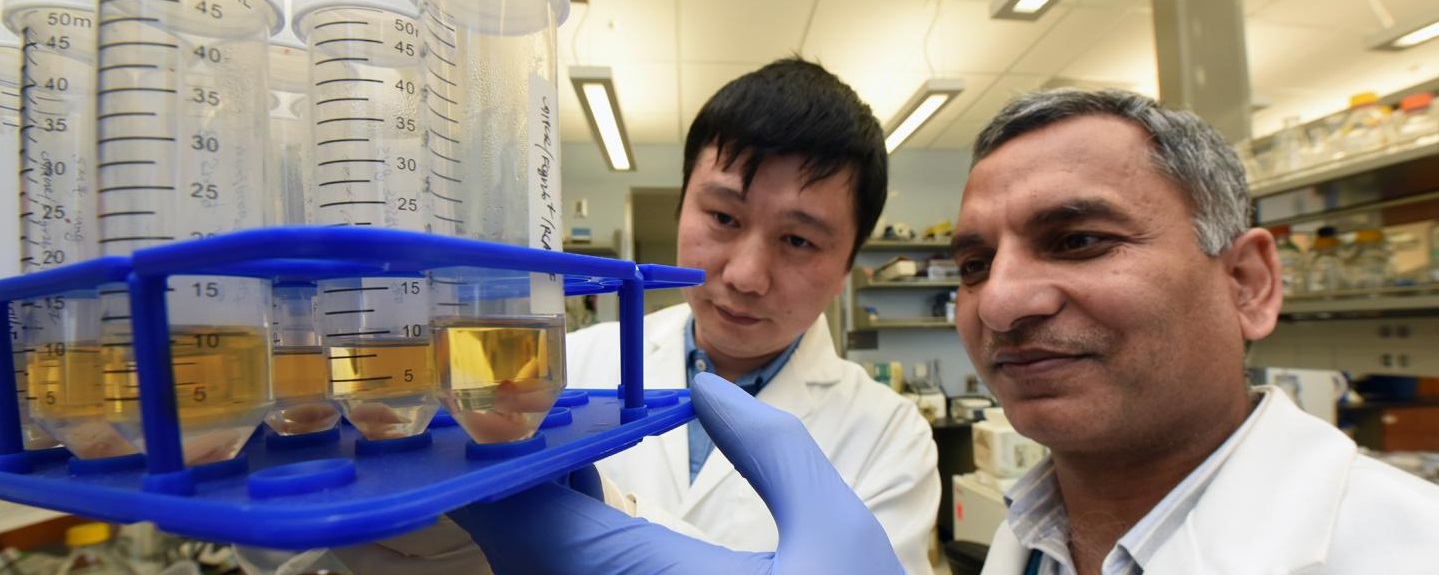Singh Laboratory

Dr. Nagendra Singh
Professor, Department of Biochemistry & Molecular Biology
Dr. Singh’s laboratory studies molecular and cellular mechanisms of underlying immune
responses against pathogens and cancers. We utilize a variety of immunological, epigenetic,
molecular, biochemical, and cellular techniques to study the behavior of immune cells
during pathological conditions.
One of the ongoing projects in the laboratory involve studying the development, survival,
and function of plasma cells. Plasma cells are factory for producing antibodies molecule
that neutralize the invading pathogens. Understanding of these mechanisms is critical
in designing improved vaccines against pathogens.
His other research interest includes how T cells are activated and generate immune
responses and help other immune cells to successfully eliminate invading pathogens
and cancers. Under this project, he is studying how T cells become exhausted or toothless
during chronic infection and cancers.
Previously, he discovered the mechanism underlying dietary fiber mediated induction
of anti-inflammatory mechanisms in intestine such as Treg cells leading to suppression
of intestinal inflammation and cancers.
His research is funded by extramural sources such as NIH/NIAID.
Selected Publications:
- Yang W, Yu T, Huang X, Bilotta AJ, Xu L, Lu Y, Sun J, Pan F, Zhou J, Zhang W, Yao
S, Maynard CL, Singh N, Dann SM, Liu Z, Cong Y. Intestinal microbiota-derived short-chain fatty acids regulation
of immune cell IL-22 production and gut immunity. Nature Communications Sep 8;11(1):4457 (2020). doi: 10.1038/s41467-020-18262-6.PMID: 32901017.
- Zhu H, Bhatt B, Sivaprakasam S, Cai Y, Liu S, Kodeboyina SK, Patel N, Savage NM, Sharma
A, Kaufman RJ, Li H and Singh N. Ufbp1 promotes plasma cell development and ER expansion by modulating distinct branches
of UPR. Nature Communications March 6 10(1):1084 (2019).
- Bhatt B, Zeng P, Zhu H, Sivaprakasam S, Li S, Xiao H, Dong L, Shiao P, Kolhe R, Patel
N, Li H, Levy-Bercowski D, Ganapathy V, Singh N. Gpr109a Limits Microbiota-Induced IL-23 Production to Constrain ILC3-Mediated Colonic
Inflammation. J Immunology Mar 7 (2018). [Epub ahead of print] PMID: 29514953.
- Zhu H, Lemos H, Bhatt B1, Islam BN, Singh A, Gurav A, Huang L, Browning DD, Mellor A, Fulzele S and Singh N. Carbidopa, a drug in use for management of Parkinson disease inhibits T cell activation
and autoimmunity. PLoS One Sep 12;12(9):e0183484 (2017).
- Sivaprakasam S, Gurav A, V Paschall A, Coe GL, Chaudhary K, Cai Y, Kolhe R, Martin P, Browning D, Huang
L, Shi H, Sifuentes H, Vijay-Kumar M, Thompson SA, Munn DH, Mellor A, McGaha TL, Shiao
P, Cutler CW, Liu K, Ganapathy V, Li H, and Singh N. An essential role of Ffar2 (Gpr43) in dietary fibre mediated promotion of healthy
composition of gut microbiota and suppression of intestinal carcinogenesis. Oncogenesis 5, e238 (2016); doi:10.1038/oncsis.2016.38
- Cai Y, Pi W, Sivaprakasam S, Zhu X, Zhang M, Chen J, Makala L, Lu C, Wu J, Teng Y,
Pace B, Tuan-Lo D, Singh N*, Li H*. Indispensable role of the Ufm1 conjugation system in hematopoietic stem cell
survival and erythroid development. PLoS Genet. 11:e1005643 (2015). (*corresponding authors)
- Singh N*, Gurav A, Sivaprakasam S, Brady E, Padia R, Shi H, Thangaraju M, Prasad PD, Manicassamy S, Munn DH, Lee JR, Offermanns S, & Ganapathy V*. Activation of Gpr109a, Receptor for Niacin and the Commensal Metabolite
Butyrate, Suppresses Colonic Inflammation and Carcinogenesis. Immunity 40:128 (2014) PMID: 24412617 (*corresponding authors)
- Zhang M, Zhu X, Zhang Y, Cai Y, Chen J, Sivaprakasam S, Gurav A, Pi W, Makala L, Wu
J, Pace B, Tuan-Lo D, Ganapathy V, Singh N* and Li H*. RCAD/Ufl1, an Ufm1 E3 ligase, is essential for hematopoietic stem cell
function and murine hematopoiesis. Cell Death Differ. Dec, 22:1922 (2015). (*corresponding authors)
- Singh N, Yamamoto M, Takami M, Seki Y, Takezaki M, Mellor AL, and Iwashima M. CD4+CD25+ regulatory
T cells resist a novel form of CD28-and Fas-dependent p53-induced T cell apoptosis.
J Immunology 184:94 (2010) PMID: 19949106
- Singh N, Chandler PR, Seki Y, Baban B, Takezaki M, Kahler DJ, Munn DH, Larsen CP, Mellor
AL, and Iwashima M. Role of CD28 in fatal autoimmune disorder in scurfy mice. Blood 110:1199 (2007) PMID: 17463170
- Singh N, Seki Y, Takami M, Seki Y, Baban B, Chandler P, Khosravi D, Zheng X, Takezaki M,
Lee JR, Mellor AL, Bollag W and Iwashima M. Enrichment of regulatory CD4+CD25+ T cells
by inhibition of phospholipase D signaling. Nature Method 3:629 (2006) PMID: 16862138


